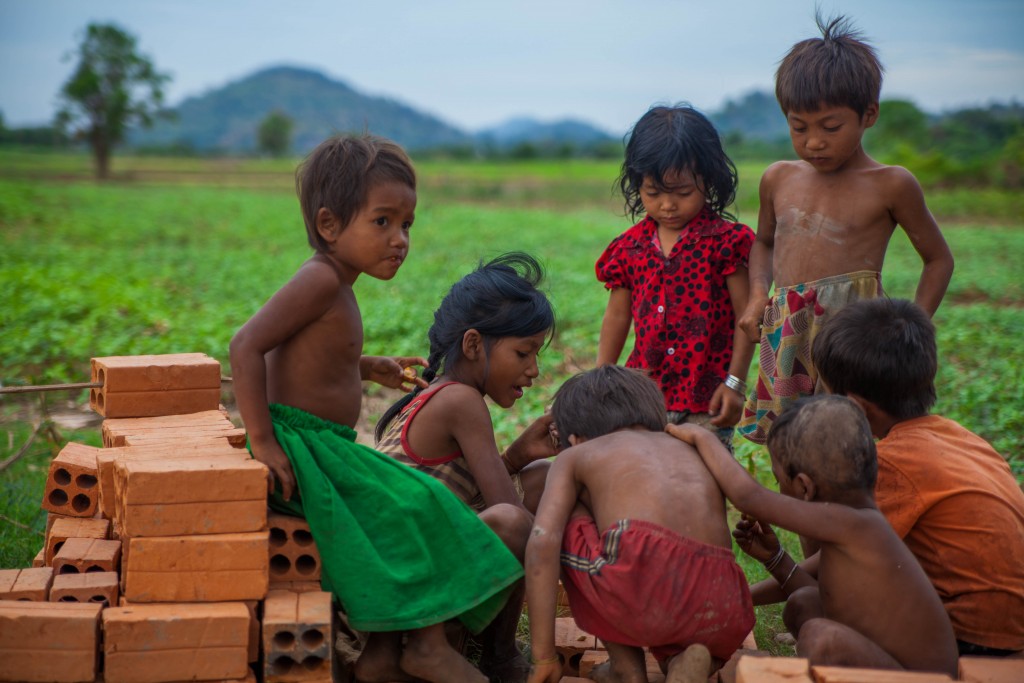
កុមារកំពុងធ្វើការជាមួយនឹងដុំឥដ្ឋ នៅប្រទេសកម្ពុជា។ រូបភាព ថតដោយ ជា សុដានី កាលពីថ្ងៃទី៦ ខែ មិថុនា ឆ្នាំ២០១៣។ ក្រោមអាជ្ញាប័ណ្ណ CC BY 2.0។
ប្រទេសកម្ពុជា មានប្រជាជនសរុបជាង១៥លាននាក់ ដែលភាគច្រើនមានអាយុក្រោយ៣០ឆ្នាំ។ មនុស្សប្រហែលជា ២៥០,០០០នាក់ ឈានជើងចូលទីផ្សារការងារ ជារៀងរាល់ឆ្នាំ។1 បើទោះបីជាមានកំណើនផលិតផលក្នុងស្រុកសរុបជាមធ្យមប្រមាណជា ៧ភាគរយ ក្នុង មួយឆ្នាំ នៅប្រមាណជាមួយទសវត្សរ៍ចុងក្រោយនេះ ភាពអត់ការងារធ្វើ នៅតែជាកត្តានៃការព្រួយបារម្ភ ក្នុងចំណោមប្រជាជនវ័យក្មេងរបស់ប្រទេសនេះ។2 តើរាជរដ្ឋាភិបាល នៃ ព្រះរាជាណាចក្រកម្ពុជា អាចធានាបានដោយរបៀបណាថា តម្រូវការទីផ្សារការងារ អាចឆ្លើយតបទៅនឹងការឈានជើងចូលទៅទីផ្សារការងារ របស់ប្រជាជនវ័យក្មេងទាំងនេះ ក្នុងចំនួនមួយដ៏ច្រើន?
ប្រជាជនកម្ពុជានៅតាមជនបទស្ទើរតែទាំងអស់ ត្រូវបានជឿថា ប្រកបរបរនៅក្នុង វិស័យកសិកម្ម ។ កម្លាំងពលកម្មភាពច្រើន ត្រូវបានស្រូបយកដោយវិស័យកសិកម្ម។ ខណៈពេលដែល ប្រជាជនប្រមាណជា២២ភាគរយ រស់នៅទីក្រុង ភាគច្រើនលើសលប់នៃប្រជាជនកម្ពុជា (ប្រហែល៧៨ភាគរយ) រស់នៅតំបន់ជនបទ។3
ក្រៅពីវិស័យកសិកម្ម ការអភិវឌ្ឍន៍ឧស្សាហកម្ម កាត់ដេរសំលៀកបំពាក់ និង ទេសចរណ៍ ត្រូវបានរាជរដ្ឋាភិបាលមើលឃើញថា ជាគន្លឹះ សម្រាប់ការបង្កើតការងារ។ នៅត្រឹមឆ្នាំ២០១៨ វិស័យឧស្សាហកម្មទាំងពីរនេះ ត្រូវបានរំពឹងទុកថា នឹងចូលរួមបង្កើត ការងារសម្រាប់ប្រជាជនកម្ពុជាវ័យក្មេងប្រមាណជា ១.៤ លាននាក់។4 ការប៉ាន់ប្រមាណនេះ ប្រហែលជានៅតែទាប ឧបមាថា ឧស្សាហកម្មការដេរសម្លៀកបំពាក់ និង វាយនភ័ណ្ឌ តែម្នាក់ឯង បានផ្តល់ការងារធ្វើឱ្យប្រជាជនប្រមាណរវាងពី ៦៥០,០០០ ទៅ ៧០០,០០០នាក់រួចទៅហើយនោះ នៅក្នុងឆ្នាំ២០១៤ និងឆ្នាំ២០១៥។5
ផែនការយុទ្ធសាស្ត្រអភិវឌ្ឍន៍ជាតិ ២០១៤-២០១៨ បង្ហាញផ្លូវសម្រាប់ ផែនការយុទ្ធសាស្ត្រសម្រាប់ការអភិវឌ្ឍន៍ក្នុងវិស័យការងារ និងការបណ្តុះ បណ្តាល ឆ្នាំ២០១៤-២០១៨។ ខណៈពេលដែលកសិកម្ម គឺជាវិស័យ សេដ្ឋកិច្ចមួយដ៏សំខាន់ ដែលត្រូវបានផ្តល់អាទិភាពដោយរាជរដ្ឋាភិបាល នគរូបនីយកម្មក៏ជាផ្នែកស្នូរនៃផែនការយុទ្ធសាស្ត្រអភិវឌ្ឍន៍ជាតិ ២០១៤- ២០១៨ ផងដែរ។ យ៉ាងណាម៉ិញ ផលនៃកំណើនសេដ្ឋកិច្ច ទៅលើការកាត់បន្ថយភាព ក្រីក្រ នៅតែជាចំណោទ ក្នុងខណៈដែលឱកាសការងារភាគច្រើន មានតែនៅទីក្រុង។
ក្រសួងអប់រំ យុវជន និងកីឡា និង ក្រសួងការងារ និងបណ្តុះបណ្តាលវិជ្ជាជីវៈ ចូលរួមយ៉ាងសកម្មនៅក្នុង ការផ្តួចផ្តើម ពិនិត្យ និងអនុវត្តគោលនយោបារដ្ឋាភិបាល និងផែនការសកម្មភាព នៅក្នុងវិស័យការងារនេះ។ ក្រសួងអប់រំ យុវជន និងកីឡា រៀបចំយុវជនកម្ពុជា ឱ្យរៀបចំខ្លួនរួចរាល់ សម្រាប់ទីផ្សារការងារ ចាប់ពីការសិក្សាថ្នាក់ទាប រហូតដល់ការបញ្ចប់ការសិក្សានៅឧត្តមសិក្សា តាមរយៈ ផែនការសកម្មភាពជាតិសម្រាប់ការអភិវឌ្ឍកុមារឆ្នាំ២០១៤-២០១៨ និង គោលនយោបាយសម្រាប់ឧត្តមសិក្សាឆ្នាំ២០៣០។ ក្រសួងការងារ និងបណ្តុះបណ្តាលវិជ្ជាជីវៈ ទទួលបន្ទុកធ្វើអធិការកិច្ចកន្លែងធ្វើការងារ ដើម្បីធានាថា គ្រប់ កន្លែងធ្វើការ បានគោរពទៅតាមនិយាមសុវត្ថិភាព និងសន្តិសុខ និងជាពិសេសច្បាប់ការងារ ទប់ស្កាត់ និងដោះស្រាយវិវាទការងារ និងបង្កើនការបង្កើតការងារ។
យ៉ាងណាម៉ិញ រដ្ឋាភិបាល នៃប្រទេសកម្ពុជា នៅតែមានការប្រឈមមួយចំនួន។ ខណៈពេលដែល សុវត្ថិភាព និងសុខភាព របស់កម្មករ អាចនឹងគំរាមគំហែងដោយ លក្ខខណ្ឌ និងបរិស្ថានការងារគ្រោះថ្នាក់ និងប៉ះពាល់សុខភាព ប្រាក់ឈ្នួលអប្បបរមា ទាប នៅតែជាបញ្ហាមួយក្នុងបណ្តាបញ្ហាប្រឈមដទៃទៀត ដែលត្រូវការចាំនូវដំណោះស្រាយដោយចេរភាព។6 ជាផលវិបាកដោយផ្ទាល់នៃការធ្វើ ចំណាកស្រុកសម្រាប់ការងារក្រៅប្រទេស ការជួញដូរមនុស្សសម្រាប់កម្លាំងពលកម្ម តែងតែមានជារើយៗនៅលើទំព័រមុខរបស់សារព័ត៌មានក្នុងស្រុក។ ជាចុងក្រោយ បើទោះបីជាមានការប្តេជ្ញាចិត្តក្នុងការគោរពសិទ្ធិកម្មករស្របតាមនិយាយអន្តរជាតិ ដែលអាចធ្វើកម្ពុជានៅក្នុងស្ថានភាពប្រកួតប្រជែងជាមួយនឹងប្រទេសជិតខាង សម្រាប់ការវិនិយោគនិងការនាំចេញ ពលកម្មកុមារ នៅតែមាននៅក្នុងឧស្សាហកម្មមួយចំនួន។
បច្ចុប្បន្នភាពចុងក្រោយ ថ្ងៃទី ១៤ ខែសីហា ឆ្នាំ២០១៥
ឯកសារយោង
- 1. តែន ស្រីនិត “ពិពណ៌ការងារសំដៅជួយនិស្សិតជ្រើសរើសរបត់ផ្លូវត្រូវសម្រាប់ការងារ” ដោយវីអូអេខ្មែរ ចុះផ្សាយ ថ្ងៃទី ២៨ ខែមេសា ឆ្នាំ២០១៥។ ចូលអាននៅថ្ងៃទី ០៥ ខែមិថុនា ឆ្នាំ២០១៥ http://www.voacambodia.com/content/career-fair-aims-to-help-students-choose-fruitful-job-paths/2739345.html។
- 2. ដេននីស រូប៊ី “យុវជនកម្ពុជាជិតពាក់កណ្តាលបារម្ភ អត់ការងារធ្វើ” ដោយ ទីភ្នាក់ងារអាណាឌូលូ ចុះផ្សាយ ថ្ងៃទី ១០ ខែសីហា ឆ្នាំ២០១៥។ ចូលអាននៅថ្ងៃទី ១៣ ខែសីហា ឆ្នាំ២០១៥ http://www.aa.com.tr/en/economy/571449–almost-half-of-cambodian-youth-fear-unemployment ។
- 3. រាជរដ្ឋាភិបាលនៃប្រទេសកម្ពុជា ផែនការយុទ្ធសាស្ត្រអភិវឌ្ឍន៍ជាតិ ២០១៤-២០១៨ បោះពុម្ពផ្សាយដោយ ក្រសួងផែនការ៖ រាជធានីភ្នំពេញ មេសា ឆ្នាំ២០១៤ ទំព័រ ៦។ មើលក្រសួងផែនការ “អគ្គនាយកដ្ឋានផែនការ៖ ផែនការយុទ្ធសាស្ត្រអភិវឌ្ឍន៍ជាតិ ២០១៤-២០១៨”។ ចូលអាននៅថ្ងៃទី ២៧ ខែឧសភា ឆ្នាំ២០១៥ http://www.mop.gov.kh/Home/NSDP/NSDP20142018/tabid/216/Default.aspx ។
- 4. ដូចខាងដើម ទំព័រ៨-៩។
- 5. សមាគមរោងចក្រកាត់ដេរនៅកម្ពុជា (GMAC) “ព្រឹត្តិបត្រ ឆ្នាំ២០១៥ ” ។ ចូលអាននៅថ្ងៃទី ០៧ ខែឧសភា ឆ្នាំ២០១៥ http://www.gmac-cambodia.org/bulletin/2015.pdf ។
- 6. រោងចក្រកាន់តែប្រសើរនៅកម្ពុជា របាយការណ៍ឧស្សាហកម្មកាត់ដេរសំយោគលើកទី៣២ បោះពុម្ពផ្សាយដោយ អង្គការពលកម្មអន្តរជាតិ និង សាជីវកម្មហិរញ្ញវត្ថុអន្តរជាតិ មិថុនា ឆ្នាំ២០១៥។ ចូលអាននៅថ្ងៃទី ០៩ ខែកក្កដា ឆ្នាំ២០១៥ http://betterfactories.org/?p=9832 ។

